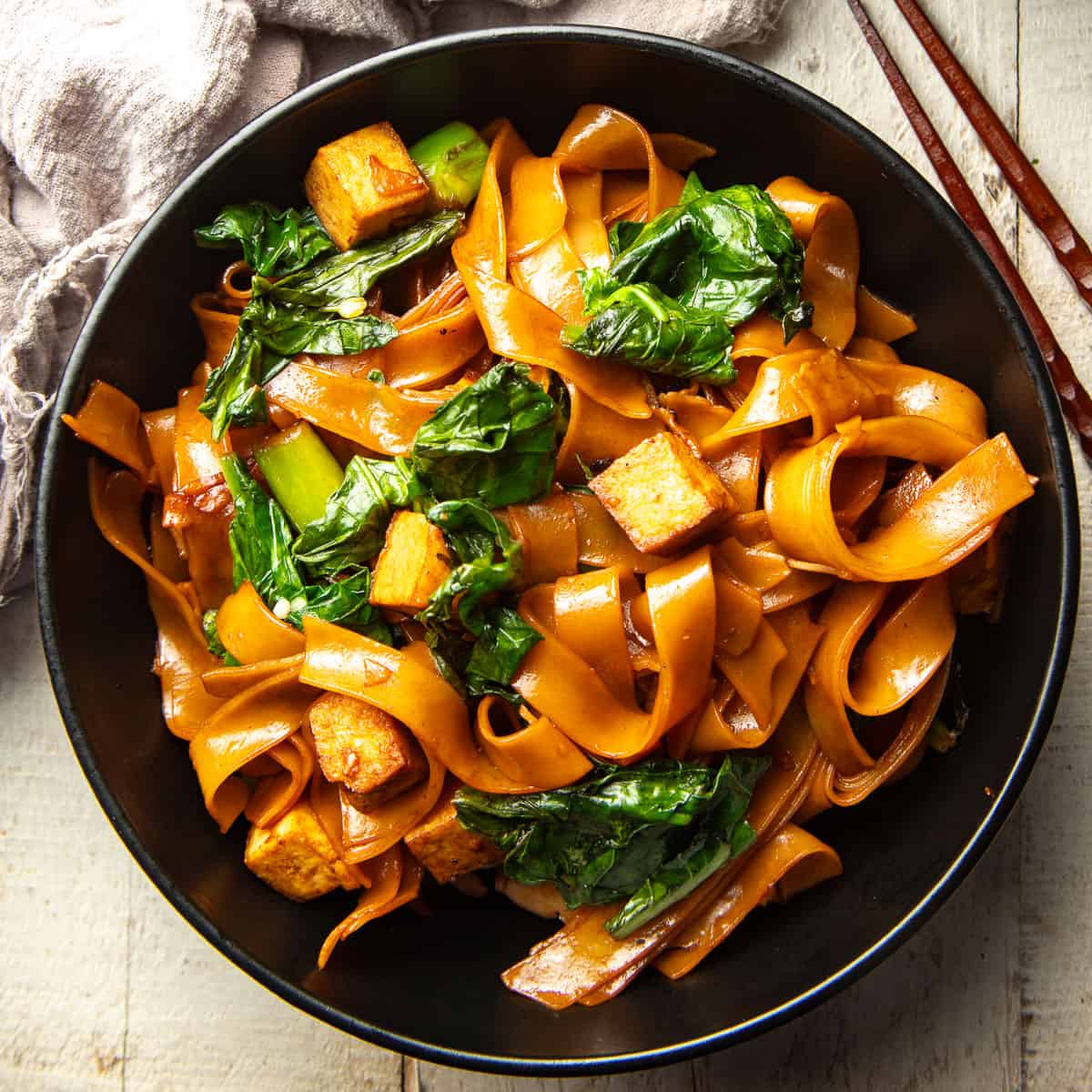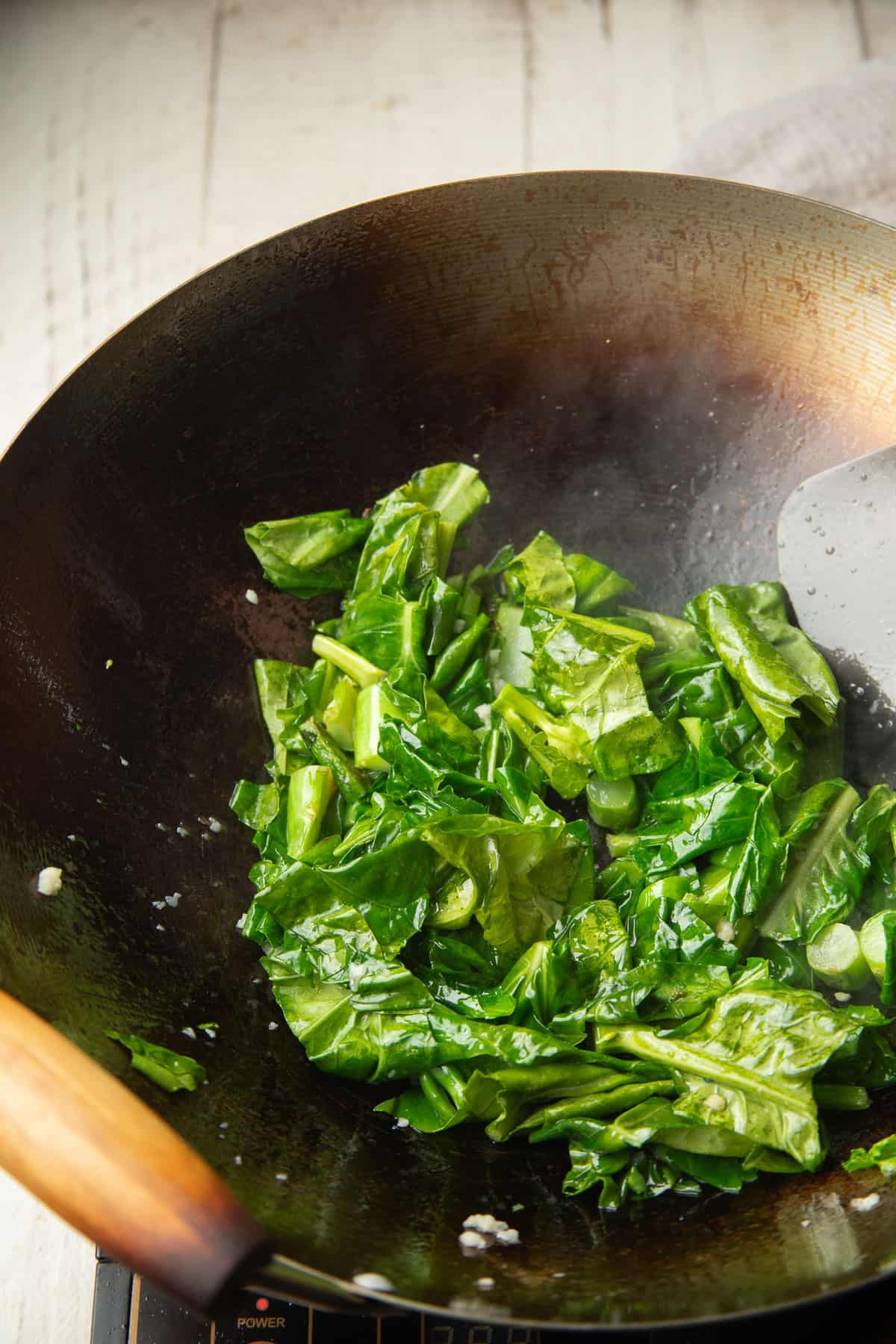This vegan pad see ew is made with stir-fried noodles, Chinese broccoli and tofu in savory sauce. This dish it absolutely flavor-packed and super easy to make…almost as easy as ordering takeout, and just as delicious!
Pad see ew is one of the most delicious Thai noodle recipes if you ask me! It doesn’t seem to get as much attention as popular dishes like pad Thai and drunken noodles, but it should. We’re working on that here today, and I’m hoping you’ll give my vegan pad see ew a try. I’m pretty sure you’ll fall in love with it if you do!
Pad see ew is a pretty simple Thai street food dish, made with stir-fried rice noodles in a rich soy-based sauce. Much of it’s flavor comes from the charring and caramelizing that happens when it’s cooked using super high heat. In this recipe we’re doing our best to recreate the cooking process used by Thai street vendors to give it that trademark smoky, salty, savory and slightly sweet flavor.
Traditional pad see ew is made with a few non-vegan ingredients including oyster sauce, eggs, and meat. Our vegan version makes a few simple swaps to keep the recipe free of animal products.
Read on to find out how it’s done!
Jump to:
Ingredients You’ll Need
- Rice noodles. Ideally you’ll want to use wide rice noodles, such as these rice sticks which are available on Amazon. Thinner noodles such as pad Thai noodles will work if that’s what’s available.
- Vegan oyster sauce. Many supermarkets sell this in the international aisle, or you can look for it in an Asian market.
- Soy sauce. This is the regular soy sauce you probably already have in your pantry.
- Dark soy sauce. This ingredient is essential for achieving that intensely rich, salty, umami flavor in your vegan pad see ew. You may need to take a trip to the Asian market to get your hands on a bottle.
- Brown sugar. Use organic brown sugar to keep the recipe vegan.
- Rice vinegar. Most grocery stores carry this. It can be found in the international aisle.
- White pepper. You can use black pepper if this isn’t available.
- Peanut oil. You’re welcome to substitute another high-heat oil, such as vegetable oil, corn oil, or canola oil.
- Super firm tofu. Extra-firm tofu also works. You’ll just need to press it before cooking.
- Chinse broccoli. Also known as gai lan or kai-lan, this is another item you’ll probably need to get from an Asian market. It’s worth the trip! Chinese broccoli is leafier and more bitter than conventional broccoli. If you really can’t get ahold of any, rapini would be my first choice of substitute, followed by broccolini.
- Garlic.
How It’s Made
The following is a detailed photo tutorial on how to make this dish. Scroll all the way down if you’d like to skip right to the recipe!
Start by cooking your noodles according to the package directions. Cook them just until they’re al dente, if possible.
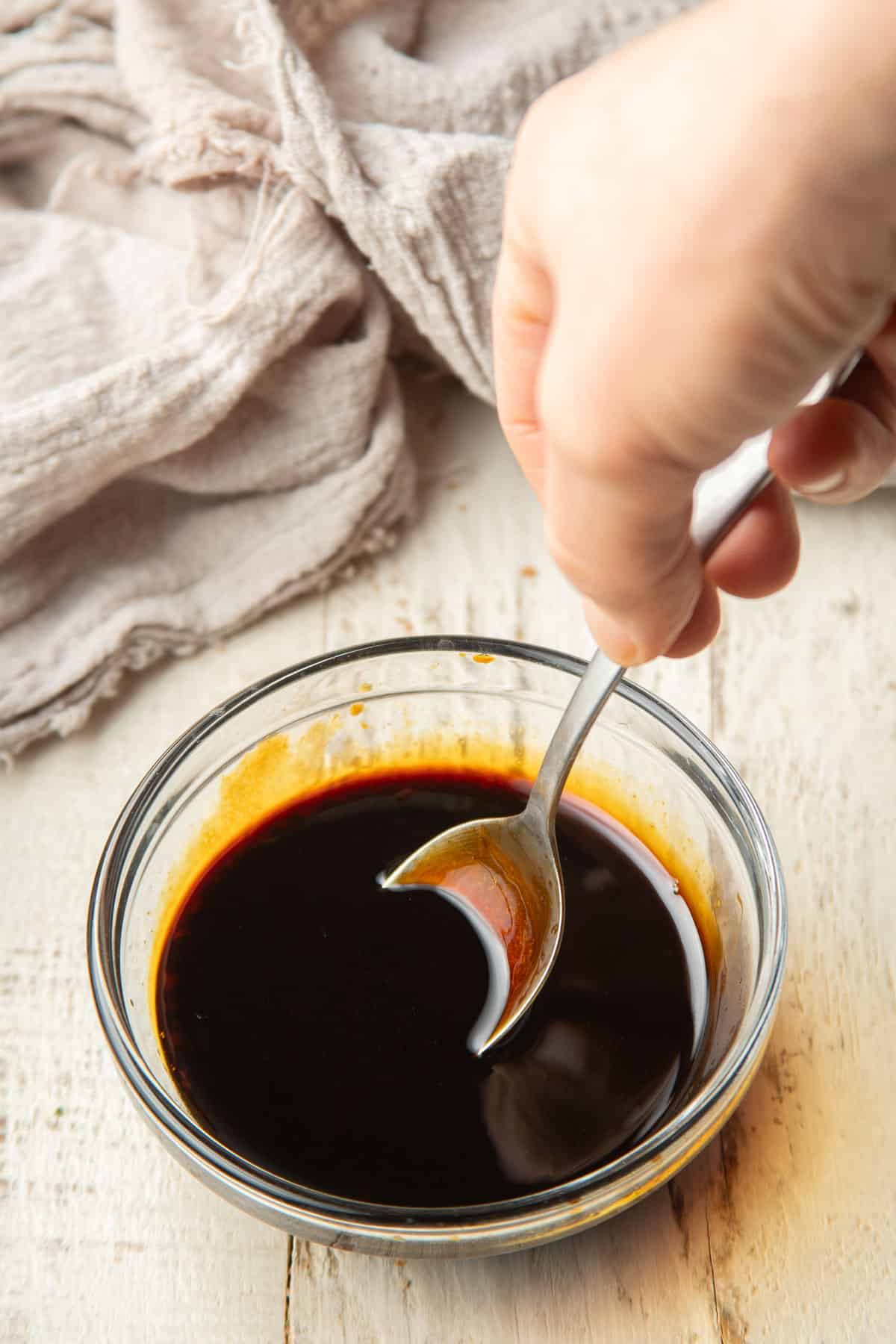
Do your prep work before you begin cooking. Chop the Chinese broccoli, separating the leaves and stems, and stir the sauce ingredients together: vegan oyster sauce, soy sauce, dark soy sauce, brown sugar, rice vinegar, and white pepper.
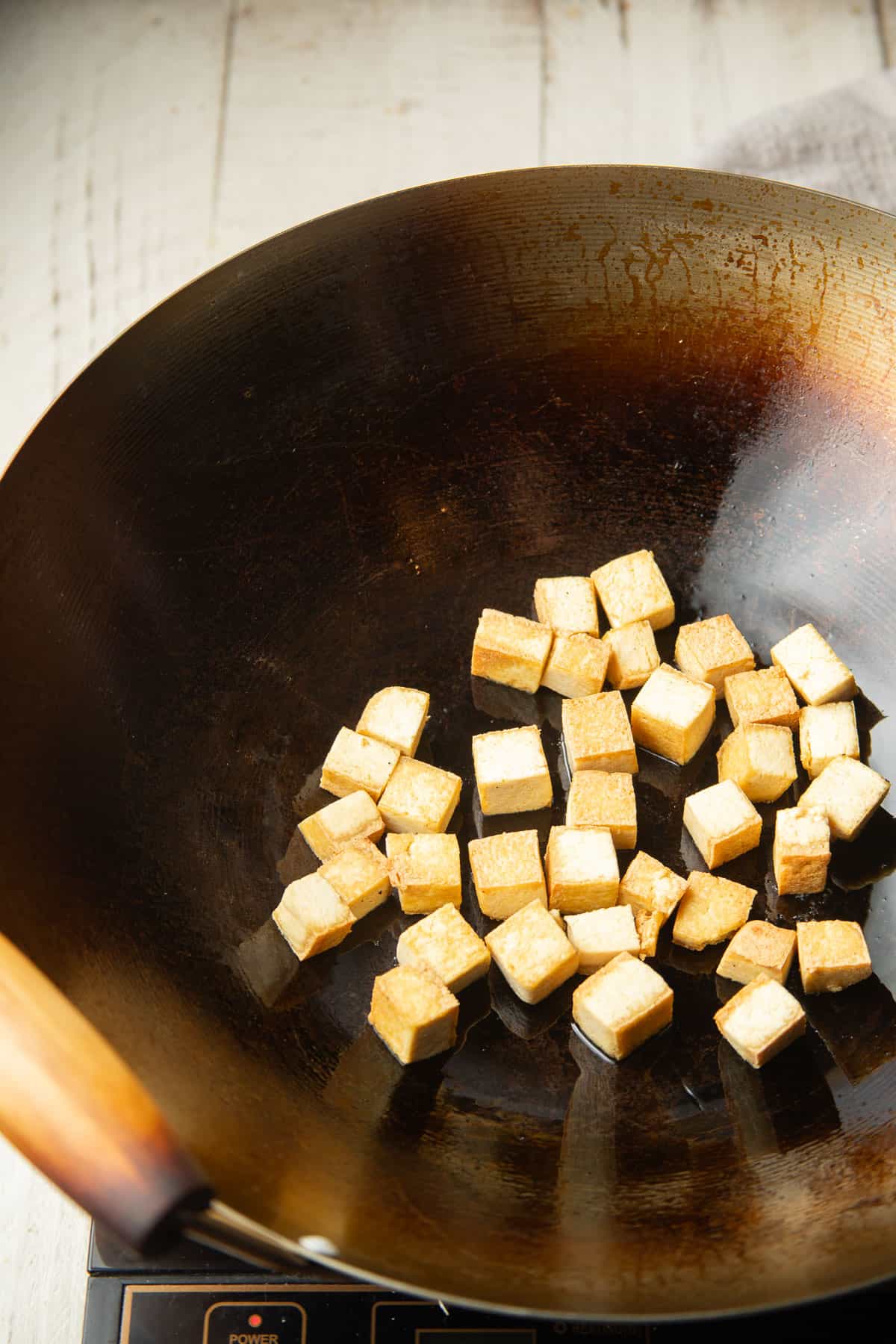
Heat some oil in a wok and add diced tofu. Cook the tofu cubes over medium heat for a few minutes, flipping them just once or twice, until the pieces are browned and crispy. Take them out of the wok and transfer them to a plate when they’re done.
Tip: You’ll need a good nonstick cooking surface for your tofu. If your wok isn’t up for the job, consider cooking the tofu in a separate vessel, such as a nonstick or cast iron skillet.
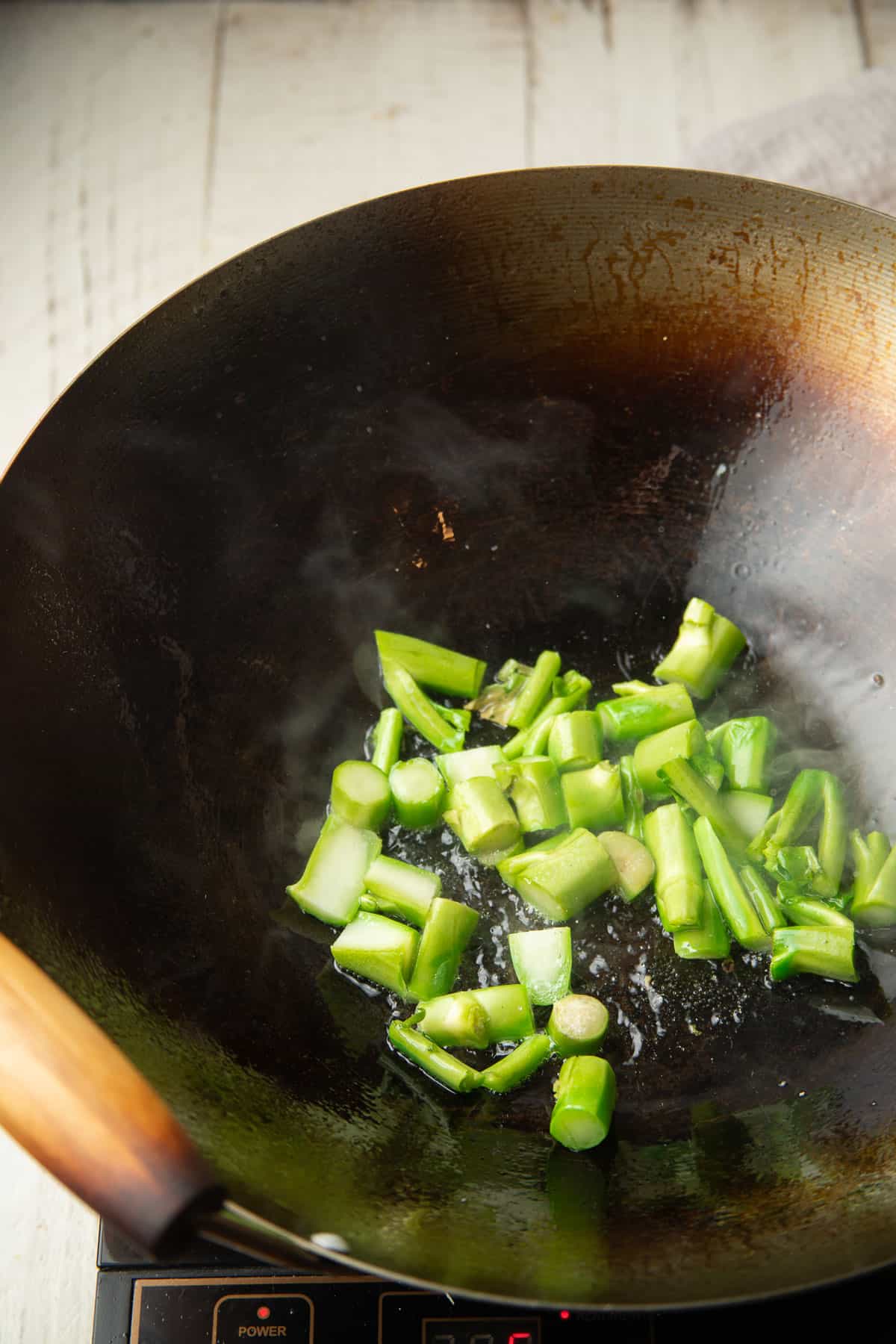
Turn the heat up to high and add some more oil to the wok. Now add just the stems from your Chinese broccoli. These will take longer to cook, so we’re starting them first! Stir-fry the stems for about a minute.
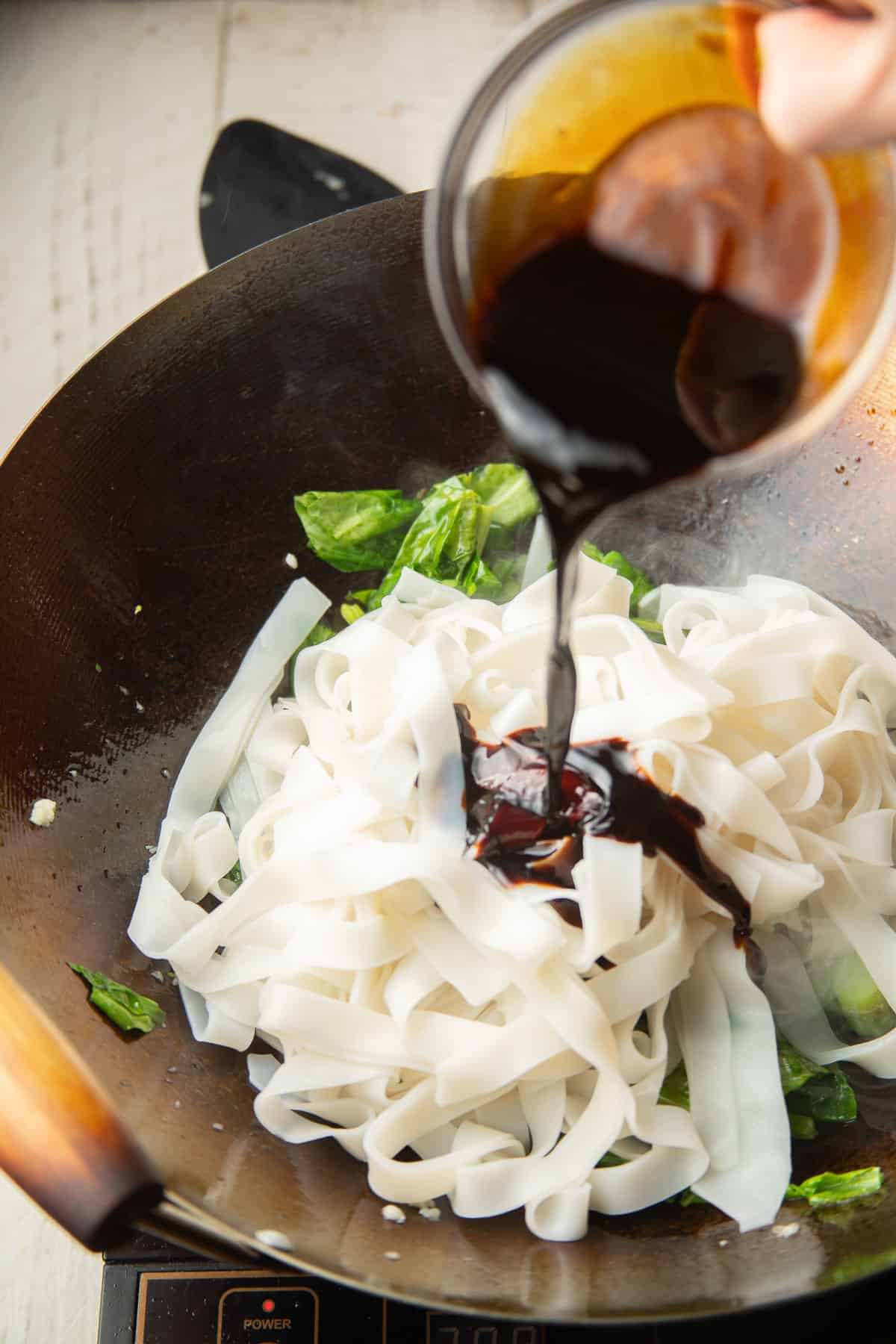
Add your cooked noodles to the wok, then carefully pour the sauce over the noodles. Be super careful when doing this, and avoid pouring the sauce directly on the cooking surface or it will sputter.
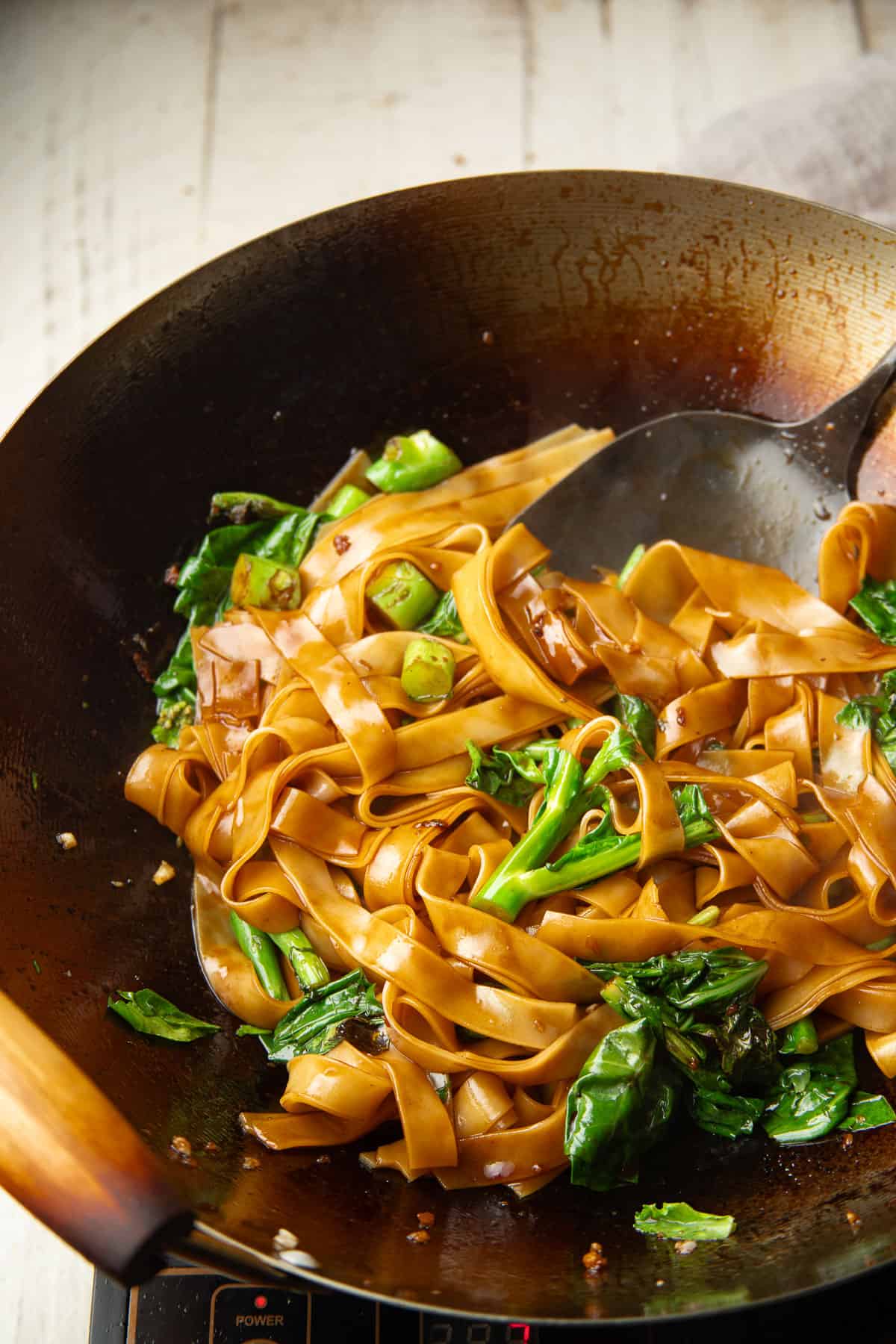
Stir-fry everything together, keeping the heat high and making sure to scrape the bottom of the wok with a spatula as you flip everything. You’ll want to incorporate all the little caramelized bits of sauce into the dish for maximum flavor!
Tip: Stop stir-frying for a few seconds every so often, letting the mixture sit and cook continuously on the hot surface. This will give you lots of those little charred and caramelized bits, which will add lots of smoky flavor to your pad see ew.
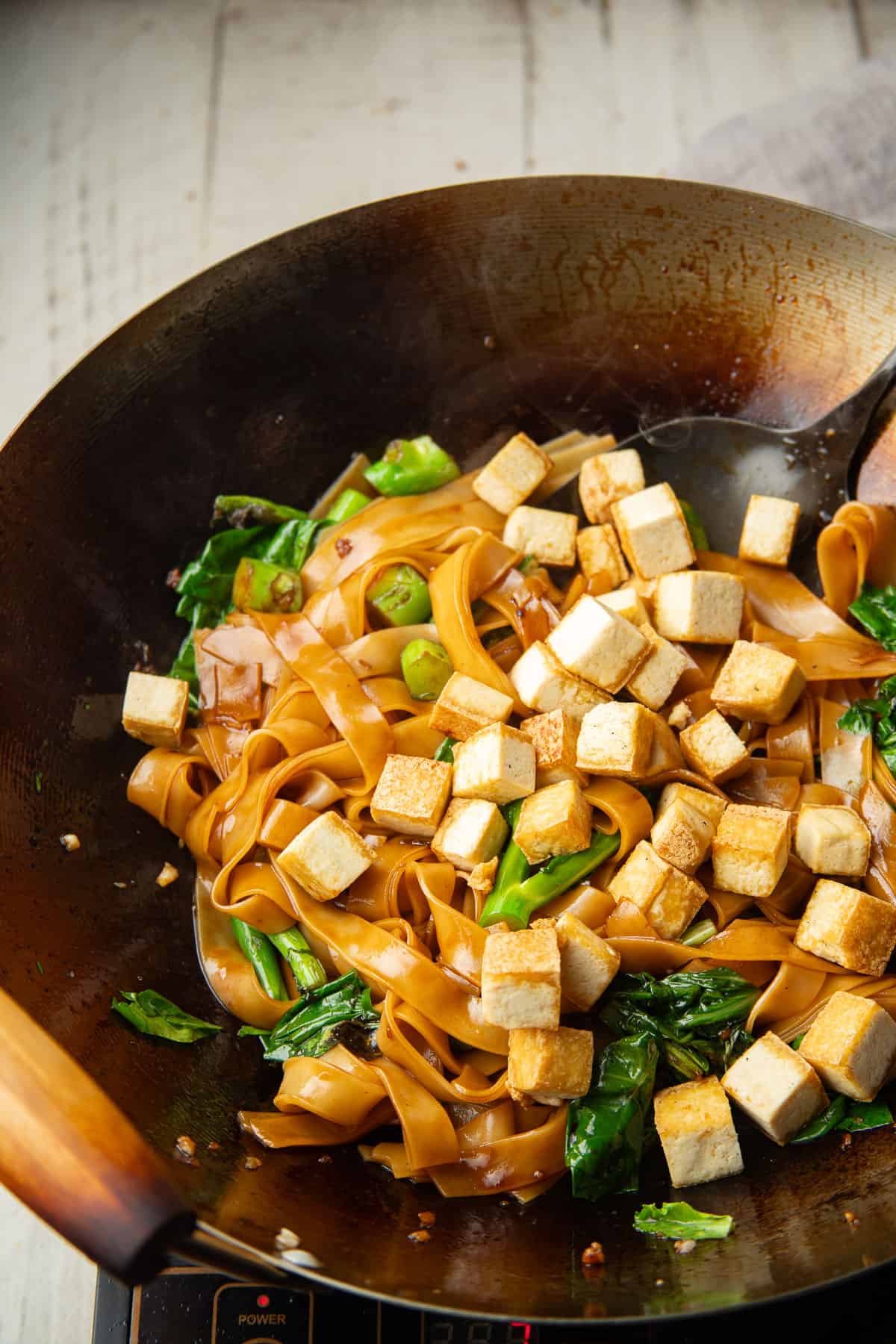
Now return the pan-fried tofu cubes to the wok.
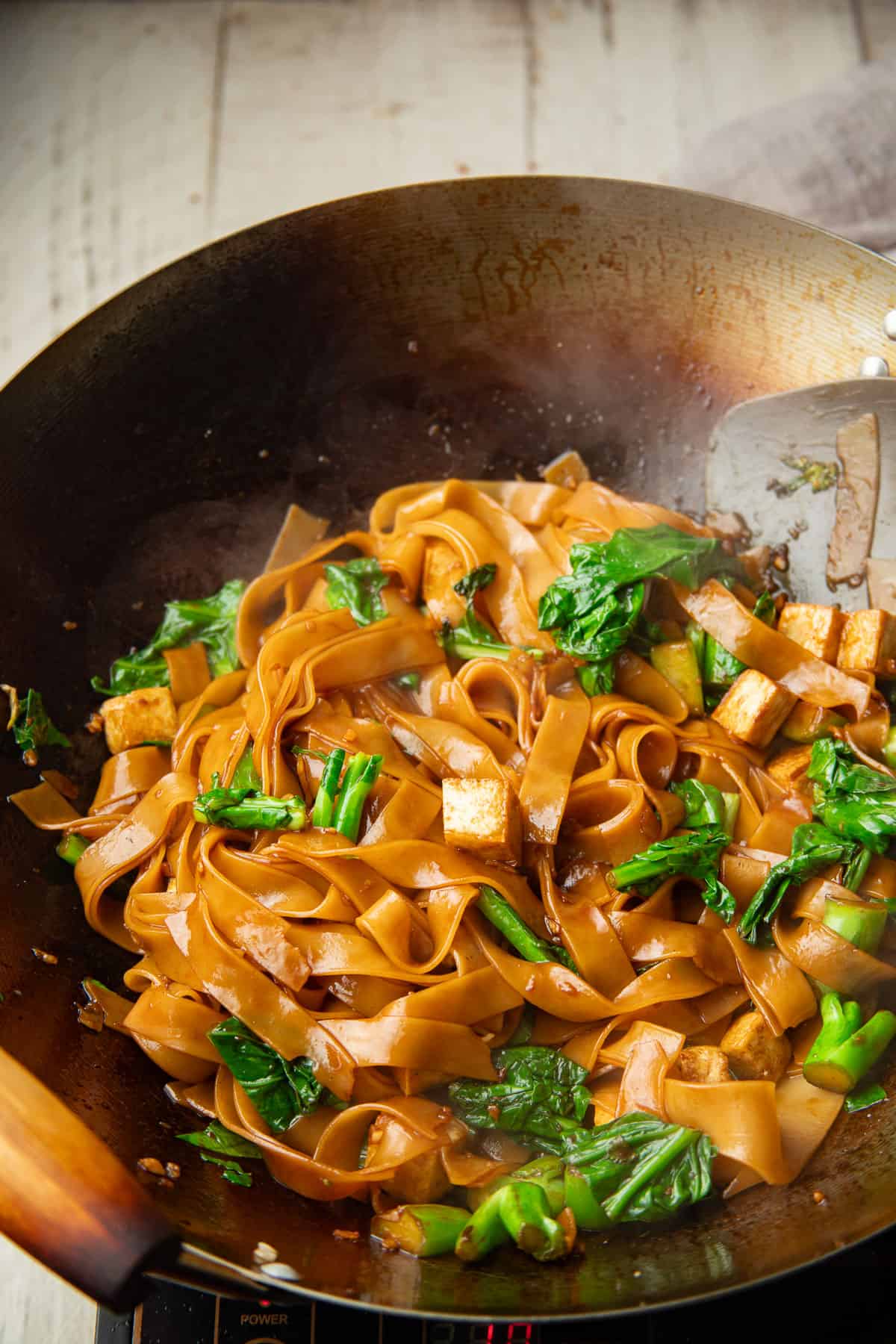
Mix the tofu in, and stir-fry everything for a few moments more to heat up the tofu.
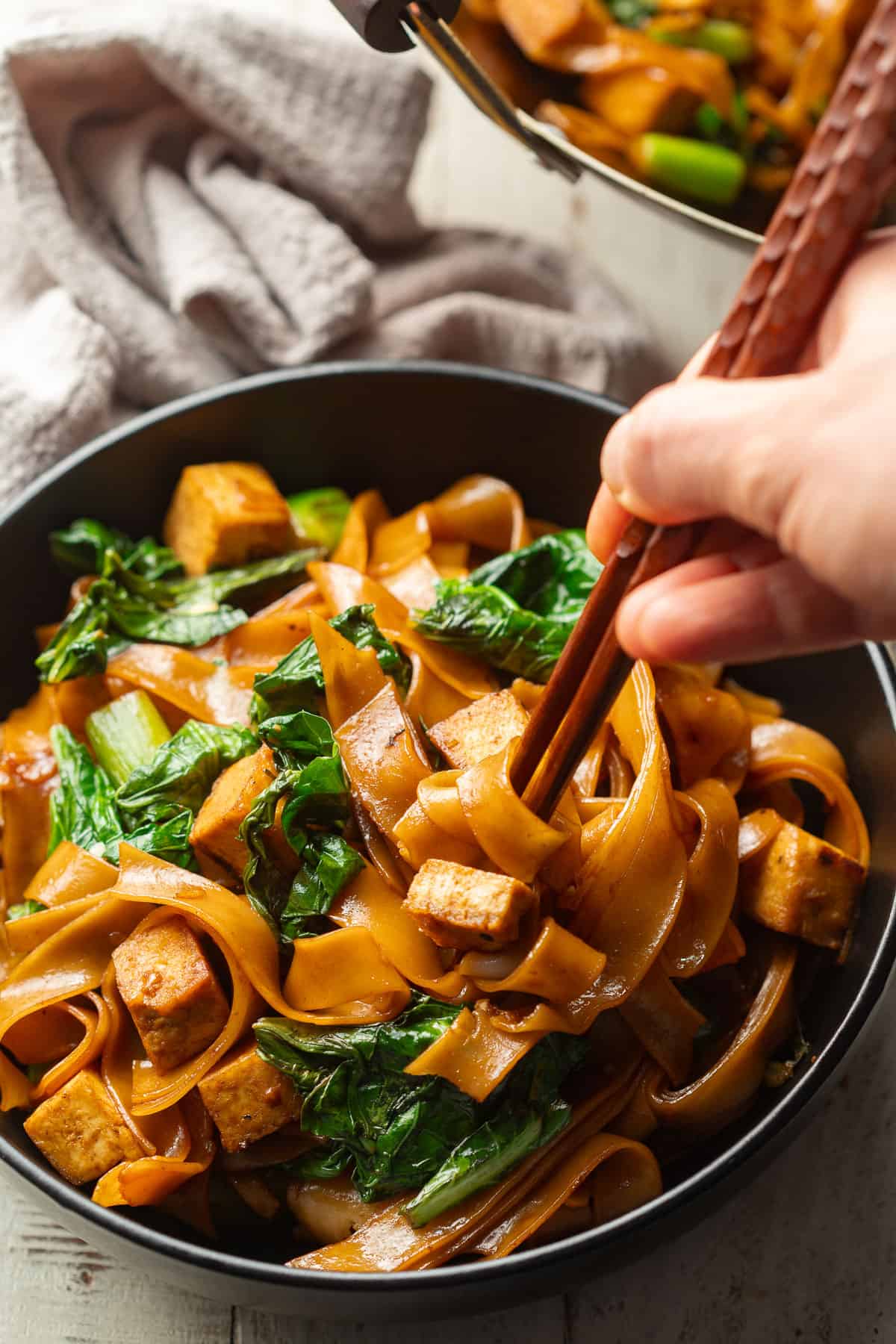
Take the wok off of heat. Your vegan pad see ew is ready to serve! Divide it into bowls or onto plates and dig in right away, while it’s hot.
Leftovers & Storage
Leftover pad see ew will keep in an airtight container in the fridge for about 3 days. You can reheat it in the microwave, or by briefly stir-frying it over high heat in your wok.
More Vegan Thai Recipes
Like this recipe? If so, please stop back and leave me a review and rating below if you try it! Also be sure to follow me on Facebook, Pinterest or Instagram, or subscribe to my newsletter for more recipes like this one!
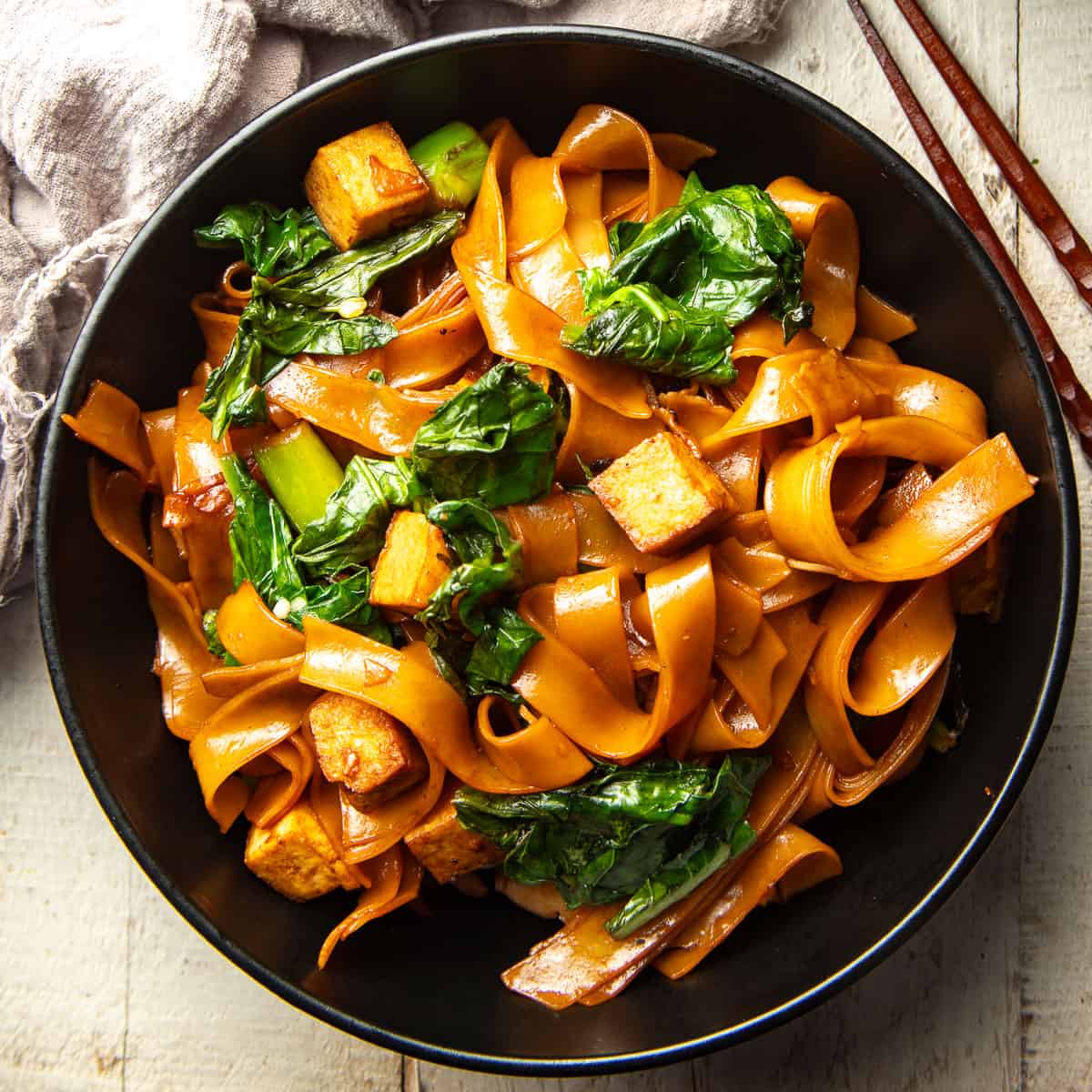
Vegan Pad See Ew
This vegan pad see ew is made with stir-fried noodles, Chinese broccoli and tofu in savory sauce. This dish it absolutely flavor-packed and super easy to make…almost as easy as ordering takeout, and just as delicious!
Ingredients
For the Sauce
-
2
tablespoons
vegan oyster sauce -
2
tablespoons
soy sauce -
1
tablespoon
dark soy sauce -
2
teaspoons
organic brown sugar -
2
teaspoons
rice vinegar -
Pinch
white pepper,
or substitute black pepper
For the Stir-Fry
-
2 ½
tablespoons
peanut oil,
divided -
8
ounces
super-firm tofu,
diced (½-inch) -
6
stalks
Chinese broccoli
(gai lan), stems and leaves separated and roughly chopped (Note 1) -
3
garlic cloves,
minced
Instructions
-
Cook the noodles according to the package directions, until al dente or slightly firm. Drain them into a colander and rinse them with cold water when they’re done.
-
Stir the sauce ingredients together in a small bowl or container.
-
Coat the bottom of a wok with ½ tablespoon of the peanut oil and place it over medium heat. (Note 2)
-
Once the oil is hot, add the tofu cubes in an even layer. Cook the tofu for about 10 minutes, until golden brown and crispy, flipping the pieces just once or twice so that they brown on multiple sides. Remove the tofu from the wok and transfer it to a plate when done.
-
Add the remaining oil to the wok and raise the heat to high.
-
Once the oil is hot, add the Chinese broccoli stems only. Stir-fry the stems for about 1 minute, until they deepen in color.
-
Add the Chinese broccoli leaves and the garlic to the wok. Stir-fry everything for about 1 minute, until the leaves have wilted.
-
Add the noodles to the wok, then pour the sauce over the noodles. Use a heatproof spatula to mix everything up and stir-fry the mixture. Occasionally stop mixing and let everything sit for a few seconds to get some charring and caramelizing of the ingredients on the bottom of the wok. Continue this process for one to two minutes.
-
Return the tofu to the wok and stir-fry everything for a few seconds more.
-
Remove the wok from heat. Divide the mixture onto plates and serve immediately.
Recipe Notes
- Cut the stems into about 1-inch pieces. You can also halve or quarter any thick pieces in the lengthwise direction if they are very thick. Chop the leaves into about 2-inch or bite-sized pieces.
- If your wok doesn’t have a good nonstick surface, consider using a skillet or other cooking vessel that does to cook your tofu, as it has a tendency to stick. The remainder of the dish will be cooked in the wok.
Nutrition Facts
Vegan Pad See Ew
Amount Per Serving
Calories 367
Calories from Fat 90
% Daily Value*
Fat 10g15%
Saturated Fat 2g10%
Polyunsaturated Fat 4g
Monounsaturated Fat 4g
Sodium 988mg41%
Potassium 251mg7%
Carbohydrates 58g19%
Fiber 3g12%
Sugar 6g7%
Protein 9g18%
Vitamin A 1482IU30%
Vitamin C 12mg15%
Calcium 99mg10%
Iron 3mg17%
* Percent Daily Values are based on a 2000 calorie diet.
